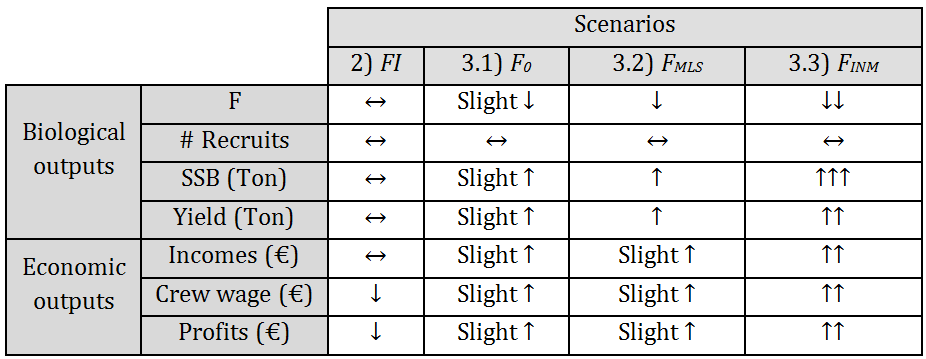

Spanish mixed demersal fishery in the W. Med
The Balearic Islands (Western Mediterranean) are considered an independent unit for assessment and management purposes in the western Mediterranean (Quetglas et al., 2012). The main target stocks of the Bottom Trawl Fleet (BTF) from the Balearic Islands are overexploited (Quetglas et al., 2017). Among them, European hake (Merluccius merluccius) shows the worst stock status. The incongruence between the MLS and the length at first capture (being the former higher than the later) results in hake being the most discarded demersal resource of the BTF from the Balearic Islands (Guijarro and Massuti, 2006).
Model used
The bio-economic analysis of hake caught by the BTF from the Balearic Islands was done using MEFISTO (Mediterranean Fisheries Simulation Tool; MEFISTO is a bio-economic fisheries simulation model based on an age-structured population dynamics that was specifically designed to address management issues under the Mediterranean regulation system (Lleonart et al., 2003).
Conclusion :
We have assessed the impact of a full implementation of the LO, as well as other scenarios aimed at improving the gear selectivity for hake in the BTF from the Balearic Islands. Among the different modelled scenarios, the most effective measure was to avoid taking individuals below the size at first maturity. The improvements observed at medium term in both the biological and economical indicators are very high, once overcome the losses observed after the first years of the implementation. However, such an increase in mesh size to manage hake would also entail important losses given that adults of other species with commercial value would not be caught. It was not possible to implement a multispecies approach of this bio-economic model due to limitations in the available data needed as initial input for the model.
Modelling the avoidance of hake individuals of age zero and hake below the MLS gave similar results, with slight increases in all indicators (biological and economic), relative to Business as usual (BAU). The worst outputs were observed for the scenario modelling the full implementation of the LO, which entailed reductions in the crew wage and profits.

Results from the different scenarios tested using MEFISTO compared to the BAU scenario. F: fishing mortality; R: number of recruits (in thousands); SSB: spawning stock biomass (in tons). FI: Full Implementation; F0: no fishing mortality (F) at age 0; FMLS: no F for individuals under the MLS; FINM: no F for immature individuals.
The results should be taken with great care because of uncertainties in the input parameters. This affected the scenarios testing the use of selectivity measures to avoid catches of specific fractions of the population. Some of the biological parameters for these scenarios were theorized based on the existing information. Secondly, the effects of the LO in the scenario testing its full Implementation (FI) were also hypothesized due to the lack of information on how the LO will affect the fishery. Increments in the benefits from this scenario, given sale of previously discarded fish, were not applied because nowadays there are not processing industries to allow commercializing the discards in the study area.
Finally, as mentioned above, we have only been able to approach the bio-economic analysis from a monospecific point of view though hake is caught in a highly multispecific fishery. Nevertheless, the current simulations revealed that the biological and economical benefits of decreasing the fishing mortality of hake by means of improving the fishery selectivity are clear. The application of such measures in a multispecies context along with other measures like spatio-temporal management of recruitment areas can help improving the management of the Mediterranean BTF.
See also
Guijarro, B. and Massuti, E., 2006. Selectivity of diamond- and square-mesh codends in the deepwater crustacean trawl fishery off the Balearic Islands (western Mediterranean). ICES Journal of Marine Science, 63: 52-67.
Lleonart, J., Maynou, F., Recasens, L., and Franquesa, R., 2003. A bioeconomic model for Mediterranean fisheries, the hake off Catalonia (western Mediterranean) as a case study. Scientia Marina, 67: 337-351.
Quetglas, A., Guijarro, B., Ordines, F., and Massuti, E., 2012. Stock boundaries for fisheries assessment and management in the Mediterranean: the Balearic Islands as a case study. Scientia Marina, 76: 17-28.
Quetglas, A., Merino, G., González, J., Ordines, F., Garau, A., Grau, A.M., Guijarro, B., Oliver, P., and Massutí, E., 2017. Harvest Strategies for an Ecosystem Approach to Fisheries Management in Western Mediterranean Demersal Fisheries. Frontiers in Marine Science, 4: 106.
Citation :
Fiche Spain in the Western Med, Author(s) :
Antoni Quetglas and Lucía Rueda, IEO
DiscardLess (2019) : Bioeconomic models to analyse LO effects